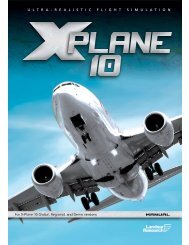Download the Plane Maker Manual - X-Plane
Download the Plane Maker Manual - X-Plane
Download the Plane Maker Manual - X-Plane
Create successful ePaper yourself
Turn your PDF publications into a flip-book with our unique Google optimized e-Paper software.
8<br />
Modifying <strong>the</strong> Appearance of an Aircraft<br />
An aircraft in <strong>Plane</strong> <strong>Maker</strong> may have a paint job applied to it by telling <strong>Plane</strong> <strong>Maker</strong> how to drape<br />
an image file over its model, or you can use 3-D objects (as might be created in Blender, Maya, 3ds<br />
Max, etc.) attached to various points of <strong>the</strong> aircraft to achieve a much higher quality appearance.<br />
8.1 Creating a Basic Paint Job<br />
The effects achievable by draping 2-D image files over a 3-D, <strong>Plane</strong> <strong>Maker</strong>-created aircraft model<br />
are perfectly acceptable, albeit not as impressive looking as what can be done with 3-D modeling<br />
tools. Creating a basic paint job in this way requires only <strong>Plane</strong> <strong>Maker</strong> and <strong>the</strong> image editor of<br />
your choice.<br />
Before beginning, be sure that your ACF model is in its final or near-final form; changing <strong>the</strong><br />
shape of <strong>the</strong> fuselage, <strong>the</strong> wings, etc. later would require you to modify <strong>the</strong> image file used in your<br />
paint texture, possibly in significant ways.<br />
We will be working primarily in <strong>the</strong> Visual Texture Regions dialog box, which is launched from<br />
<strong>the</strong> Expert menu. This dialog is used to specify which portions of your PNG texture images will be<br />
draped over each body of your aircraft. You can use <strong>the</strong> tabs along <strong>the</strong> top of this window combined<br />
with <strong>the</strong> radio buttons on <strong>the</strong> left to select which specific part you will edit. You can click and drag<br />
<strong>the</strong> regions covered by a part using <strong>the</strong> large box in <strong>the</strong> center of <strong>the</strong> window. Additionally, if you<br />
plan to use two image files in your aircraft’s textures, you can check <strong>the</strong> box next to a part labeled<br />
“use second texture.” In that case, <strong>the</strong> area of <strong>the</strong> texture image available for draping over that<br />
part will come from <strong>the</strong> second texture ra<strong>the</strong>r than <strong>the</strong> default one.<br />
For instance, if you wanted <strong>the</strong> entire top half of <strong>the</strong> default image file for your aircraft to be<br />
draped over <strong>the</strong> left side of your fuselage, you would:<br />
1. Select <strong>the</strong> Fuselage tab at <strong>the</strong> top of <strong>the</strong> dialog box,<br />
2. Click <strong>the</strong> radio button labeled “edit left side of body,” and<br />
3. Click and drag <strong>the</strong> flashing red box until it was around <strong>the</strong> entire top half of <strong>the</strong> image.<br />
Ideally, once your aircraft model is ready to use, you will set <strong>the</strong> regions of your texture to use<br />
with each part of <strong>the</strong> aircraft, <strong>the</strong>n let X-<strong>Plane</strong> create a “starting-point” texture map, which will be<br />
divided according to <strong>the</strong> geometry of your aircraft’s parts and your settings in <strong>the</strong> Visual Texture<br />
Regions dialog box. This starting-point can be opened in your image editor of choice and recolored<br />
or blended with a photo of your aircraft.<br />
87














